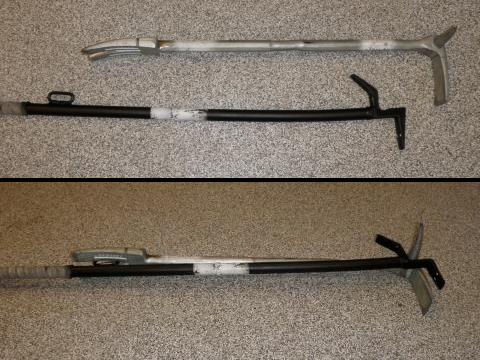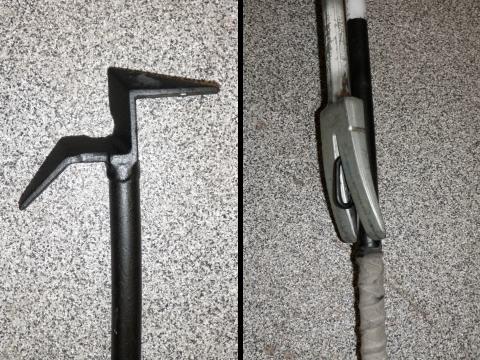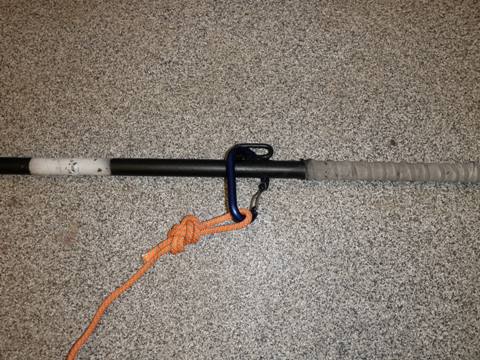Clint Mass from the Red, White, and Blue Fire District (CO) Tower 4 sent in this great tool modification. The idea behind the modification is to allow the hook and halligan to be married together in a solid fashion.

The first part of the modification involves grinding a rounded notch in the 90 degree portion of the hook (pictured below, left.) This allows the pike end of the halligan to sit in the head of the hook in a more secure fashion. The second modification involves welding a chain link in the exact spot where the fork of the halligan lands on the hook (pictured below, right.) The combination of the notch and chain link allow for the tools to remain married, and easy to carry. This married hook and halligan combination is a great combination of tools for outside functions.

The chain link can also be used as an “attachment point†for a personal escape system. As you can see in the photo below, the chain link is actually more of a “keeper†for the carabineer; the actual handle of the hook is handling the load.
A quick each way to modify the tools to make things a bit easier.


i like
great idea
If it makes it easier to “carry” as a pair, so be it.
As for the bail out piece welded on, I’ll repectfully disagree. If you are pressed to the point of having to bail out of a window, there is no time to be making this connection. You are in survival mode and you will be trying to get out in milli-seconds to save your own ass. You will also be pressed to the floor due to the heat. Remember you are bailing out due to conditions being so bad you can’t stay there any longer. I’ve had to bail out once and get out immediately and it was years before PSS was even a glint in anyones eye. Fortunately for me there was a set back roof only feet below me. I’d rather see that chain link welded to the shaft just above the fork of the halligan for the roof positioned firefighter so he can vent the upper floor windows from a flat roof using a personal utility rope. Just my opinion.
RS FDNY,
I agree with you on the bail out. The main purpose for the welded link is to make a tight fit and to avoid letting the forked end swing freely. I have tried marrying straps, but they are a pain when you are using the tools continuously. Using it for a bail out was an after thought. Just tools for the tool box.
Just want to know what is the point of a hook and a bar married together.
I think its great the way you are looking for different ways to make things work but I to wonder what good is a Halligan without something to strike it with?
Tooltime;
The halligan can be struck with the hook. Easy to show you…hard to explain. I’ll try though. Position Adz end so that the edge of it is between the door and the jamb when closed. Holding it in place there now take the bottom of the hook handle and place it between your boot tip and the door. You can now use the handle of the hook to drive in the Adz. Not the easiest or quickest way but it works. Just watch your fingers. Hope that helps. and CMAAS, thanks for your reply.
Great idea! Thanks for sharing!
I just use a rubber glove and tie them together.
JUST A FIREMAN—
ever heard of “the irons” ??
Firemen-
Both tools are typically carried together by the OV man (sorry, Firefighter assigned the Outside Vent position) and are used in conjunction with one another in carrying out his mission of VES. Marrying them just makes life earier, especially when the OV is also leaving the truck with a ground ladder.
Hey “me” your f-ing right, when someone ask for a set of irons the first thing i grap is a hook. Chris i have done ves before (OV is just fine) and both does not seem like a good idea to be running around on the fire ground. Ive have been good with either one, but each man is diffrent. RSFDNY that for the info.
I noticed the notch on the side of the forked end. For those that don’t know, it was ground in there by a sharp fireman. It allows you to understand how deep the fork is with relation to the door and jamb. If you look closer, you will see it is the same distance from the tip of the fork as is the crotch of the fork. During FE when that line is at the edge of the door and jamb you should be successfully passed teh frame and in a good position to force the door without losing the tool into the otherside or have it slip out on your side. In a smoke filled hallway it is easier to feel for the notch then to try and see where you are. Good move fellas. Another good idea is to keep a couple of wodden chocks handy and wedge them between the frame and the door as you force so as not to lose ground if the tool slips out of position.
I can’t believe while reading this people would discount what I consider two of the most valuable tools on the fireground a bar and a hook. I’ll agree to disagree with the others that don’t see the need to marry the two together. I’ve been doing it for years at my job. There isn’t anything the two tools can’t do. I do ask though when a single person grabs the irons, who’s gonna use which tool? You obviously can’t use both at the same time by yourself. If you can, I would love to meet you. The art of forcible entry is just that, an art. You should know how to force a door by your yourself and look at a two person forcible entry crew as a luxury. Not to mention, after you force open that rear door, you can vent the large bay windows on some houses or sweep the floor inside the door. You never know. Just throwin that out there before people bash the two tools married together. I am all for it!
Excellent idea Brother
Hard to tell in photos because of shadows but looks like the shoulders at fork end are squared off. Another great move.
I’ve seen this pair combination with the modification above at my last department and my current department. It’s a great combination and can easily be carried with a ladder along the beam as well.
Just a fireman,
Having 2 tools(1 being a hook) during ves is a great idea. When I VES a room I place the hook in the window extended to the floor as a point of reference. That way when you enter the room and start your systematic search you know where you started. And since you brought 2 tools in you now have a tool to clear out other windows in that room or to extend your reach during a search. Not saying that my words are gospel I just wanted to share something that works for me. That is what this job is about. Passing on information that we have to make guys more efficent. Cmaas. Great Job.
There is a reason why Hugh Halligan invented both the Halligan Bar and the Halligan Hook.
Just saying…..
Everyone brings good points to the table. For those who ask what the point of marrying or carrying two tools is, I hope that is only inexperience speaking. You ALWAYS want to be prepared to operate alone and in that case, have the tools necessary to do multiple jobs. It is critical that you enter every fireground, prepared to rescue yourself or others. It kills me to see firefighters entering a building with a 3ft fiberglass pike or plaster hook. How is that going to save you or a fellow firefighter?
An additional reason for marrying tools is to have a free hand. Climb several flights of stairs with tools in your hands and you’ll be glad to have that extra hand to reach out and grab the stair rail. Having a free hand also gives you the ability to catch yourself if you slip, trip, or fall. It beats a face plant anyday.
Come on have you guys ever heard of over kill. Dont get me wrong I’m all for having a usable tool for the job at hand but some of you act like pack mules. Please tell me how in the hell you guys carry married tools, large box lights, radio straps, hose packs with extra bottle, pockets full of tools, more lights on helment and your pockets with sprinkler stops, D rings around your ass and a ladder. Sorry Blake with all this shit you dont have a free hand. I’ll make 2 trips rather than do a face plant in the back yard at someones house at 2 in the morning.
I apologize I realize this is totally off topic, but I was wondering if any other Department’s out there besides mine uses “John Norman’s Firefighting Tactics” for promotional tests.
Hey Nick-
My job uses “selected chapters” from Norman’s book for testing. If you’re looking for more info you can contact me through http://www.fioanh.org.
Be safe Brother!
Chris
I wonder if I could hang a bleach bottle off the chain link welded on to the hook bar….
rangerbob,
Chief Halligan saw many tools being used to do the same work. So, he combined a bunch of them and came up with the Halligan Bar. Combo of the Kelly Tool and another.
There are two different versions of the “Halligan Hook” with emphasis placed on the “butt” end and the “working / hook” end. The butt end has 3 different options. a gas shut off, small fork or a rounded butt end for “breakin’ shit” The working was devised with the ability to use the angles of the tool to pry up roofing off the joists or to pull large mouldings off walls when trimming out windows or removing floor mouldings. They both work well and the time and effort that went into them combined a long career of breaking backs and necks combined with brute strength and stubborn determination along with some “let’s stop and think about this for a minute” moments.
Thanks Chris, I recently took the Lieutenanat’s test and was wondering if anyone else out there has experienced the pain of studying material all about New York City firefighting. The FDNY is a great Dept and I would never discredit them for that. I work on a Dept with barely any high rises and lot’s of new construction and we study material all about NYC firefighting for tests. I’m sorry for “venting” I just think that the job is a lot different throughout the country and there are a lot of other great department’s out there.
Boys, let’s not bicker… the most important thing about this entire site is SHARING INFORMATION! If it doesn’t work for you in your particular department, so be it! That doesn’t mean someone else out there can’t learn from it! Thanks for the info lads – and don’t let these nay-sayers keep you from trying something new and sharing what works with the rest of us!
My department has used this same type of set up for approximately three years now. Ours does differ slightly though. We have the same chainlink in place for the forked end of the haligan but, we have a small piece of one inch tubing welded to the handle of the Haligan hook. The tubing is approximately 1 inch thick and 1 inch in diameter. This keeps the tubing the same width as the handle of the hook. It is welded approximately a foot down from the hook end. This allows the hook to be used for typical pushing/pulling operations without interference from the tubing. When the Haligan is married to the hook, the point of the pick slips into the small tubing and keeps them tight together. We usually put a velcro strap around them or a small piece of utility rope girth hitched around them as an extra measure of caution because our set is carried on the outside of the apparatus. I tried to post a picture but had some difficulties. I’ll keep trying.
Correct me if i am wrong but that looks like a 6 ft hook. I have a 4 ft hook does anybody feel this application would work for that i work in a very poor older area where a 6 ft hook is never really needed just due to the residential construction that we encounter. thanks for any opinions stay safe out there
Great post Mossy. Those Mountain boys don’t have the benefit of a lot of people responding to fires, so they may have to each bring a couple to do the work. Even here in the city between the 2 backsteppers we carry Haligan, Hook, Axe or TNT, and a Can. So it is nice to have an easier way to carry them.